Plumbing Jargon Explained
Plumbers talk can sometimes be confusing and sound like gibberish to the untrained ear.
There’s 1000’s of parts and so many intricate components to your homes plumbing systems. As plumbers we’ve founded our own language and terminology to describe, explain and identify components of our trade.
We thought this would be a good opportunity to clear up some of the general plumbing jargon you may have heard from time to time and provide some basic definition to our not so common language.
Here we go!
Nipple
A brass fitting, typically with male threads on both ends. Used as a joiner to connect copper pipes or brass fittings together.

KGL or Brass Flare
A brass compression fitting used with copper pipe. Typically used for gas work.

GIO – Government Inspection Opening
A sewer inspection shaft raised to surface level located at the property boundary.
The GIO is the connection point between the authorities sewer system and your property’s sewer. The GIO is the property of the authorities.

IO – Inspection Opening
IP – Inspection Point
A sewer inspection shaft, typically raised to surface that allows access to the sewer drains. Inspection points are used for sewer cleaning purposes.

Boundary Trap
Boundary Shaft
Generally found on older properties, the boundary trap creates a water seal between the authorities drains and property drains. The boundary trap is a u bend between 1-6m below ground with inspection shafts and or a vent pipe raised to surface level.


Earthenware Drain
Terracotta Drain
Vitrified Clay Drains
Clay sewer drain made in small sections which were joined together with rubber ring joints and or mortar. Clay drains are no longer used in new buildings. Clay drains have been replaced with PVC.

PVC Drain
Polyvinyl Chloride.
A durable rigid plastic used in sewer systems.

Gully
Domestic Sink
ORG – Overflow Relief Gully
A fitting used in the sewerage system which provides a water seal to prevent odours and gases escaping from the drains.
An ORG allows any potential sewerage surcharge from the street sewer main to overflow outside as opposed to inside the home.


Vent Pipe
Allows the sewer system to breath and draw air into the system as required to prevent pressure fluctuations and encourage passage of gases.

Floor Trap
Floor Gully
A gully located inside the house (typically bathrooms and laundries), used with a grating system. Designed to act as a floor drain and has provisions for other fixtures to connect to it.

Pan
A toilet bowl.

Cistern
Tank that holds the water for the toilet flush.

Mini Cistern Cock
Small tap that connects to the toilet cistern.
Used to isolate water to the cistern for servicing.

Flushpipe
Pipe that connects the toilet cistern to the pan.

Inlet Valve
Water valve in the cistern which controls the flow of water into the cistern.

Breecher Piece
Pipe fitting (typically in the wall) that connects the hot and cold water pipes (taps) together and facilitates the mixing of water and discharge from one outlet.


Seat
A smooth brass seat in the breecher that the tap washer seals against to prevent water passing.
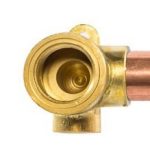
Tap Washer
A fitting that inserts in the end of the spindle (tap body) which seals against the seat to prevent water passing.
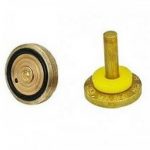
Screw Nose Bib Cock
Garden tap with a threaded outlet to allow for hose connections.

Conversion Taps
A double tap (typically used in the laundry) which allows for washing machine hose connections and laundry tap from the single connection.
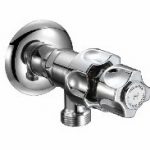
Pillar Cock
Pillar Tap
Single stand alone tap with spout built in.
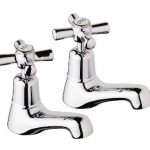
HWS
Hot water service, water heater.
Tempering Valve
A 3 way mixing device used to mix hot and cold water and temper the hot water supply to taps around your home.

Relief Valves
PTR – Pressure Temperature Relief
ECV – Expansion control valves
Safety valves associated with storage hot water heaters designed to protect the heater against excessive water pressure and temperature build up.

Duo Valve
Valve Train
A series of valves and fittings which connects the cold water inlet, of a storage hot water heater, to the water mains.
Usually incorporates the Duo valve (isolation valve), ECV (expansion control valve) and tee piece for the Tempering valve.

Sacrificial Anode
A magnesium rod installed inside storage hot water heaters, deigned to corrode (sacrifice itself) before the tank, prolonging the life of the tank.

Boundary valve
PLV – Pressure limiting valve
PRV – Pressure reducing valve
A pressure reduction device used to limit the incoming water pressure to the entire house or a particular appliance.
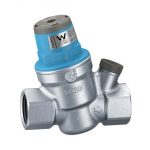
Ball Valve
A ¼ turn isolation valve used for water and gas pipework.

Water Hammer Arrestor
A device that’s connected to the water pipework which absorbs the sudden pressure changes in the system, reducing the vibration/noise and pipe bang.

Rainbank
An automatic pump system, connected to the cold water supply and rain water (rainwater tank), which feeds a toilet. The system alternates between rain water and mains water, pending rainwater supply. Mainly found on new homes.

Pilot Light
A small gas flame inside a gas appliance which is permanently lit, and used to ignite a larger burner.
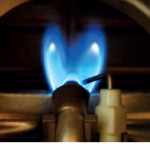
Thermocouple
A fail-safe device which senses when the pilot light is extinguished, automatically isolating the gas supply to the appliance.








